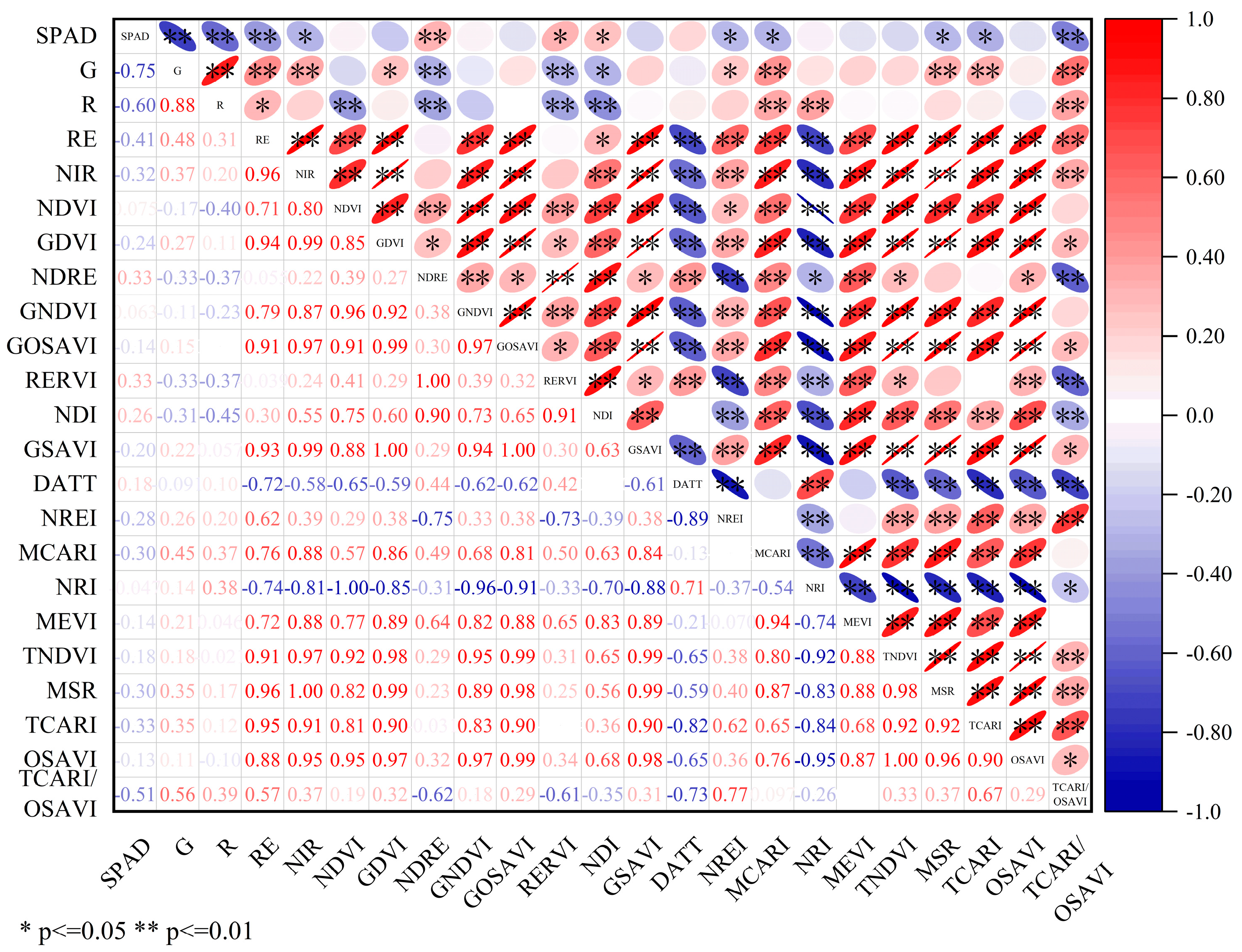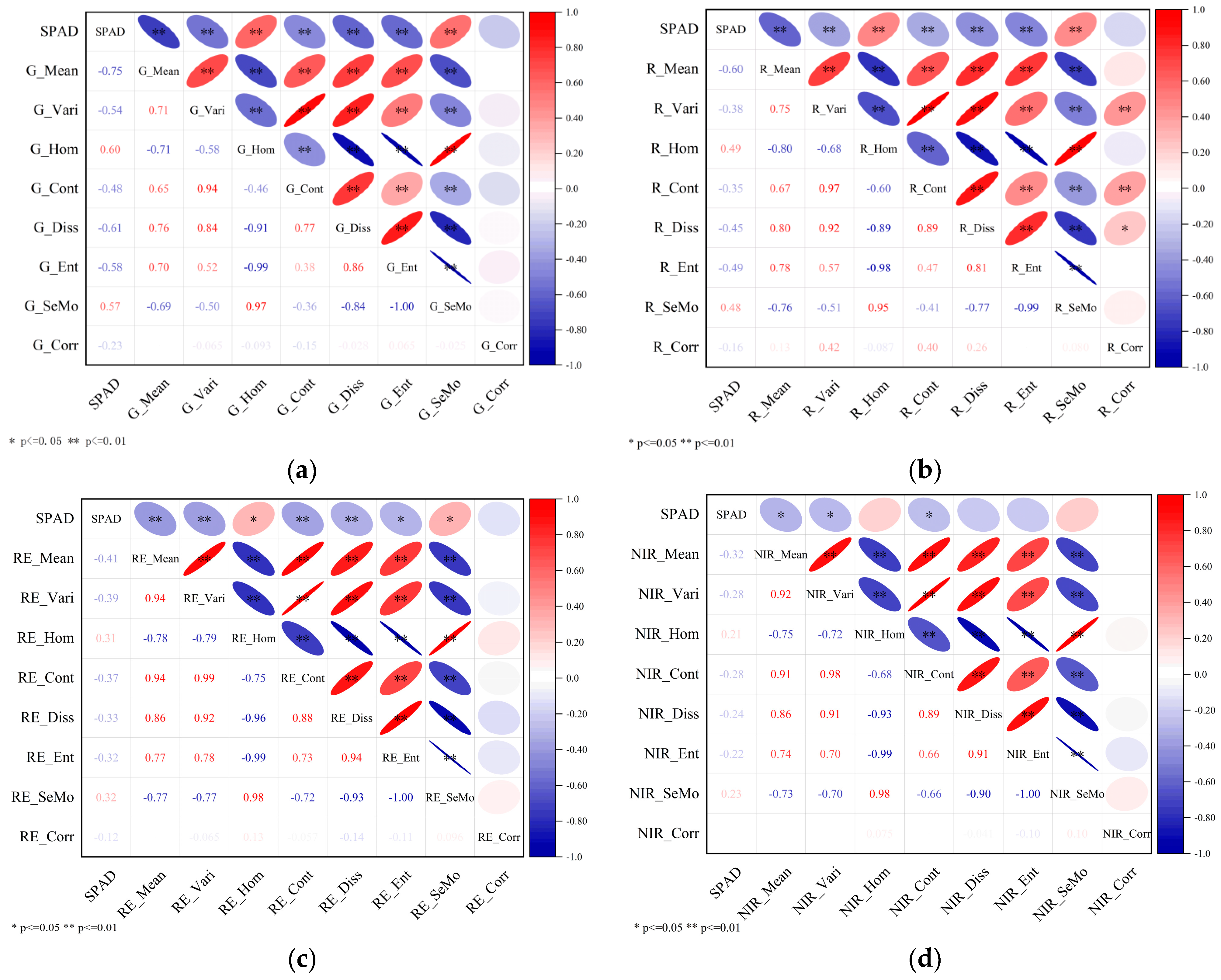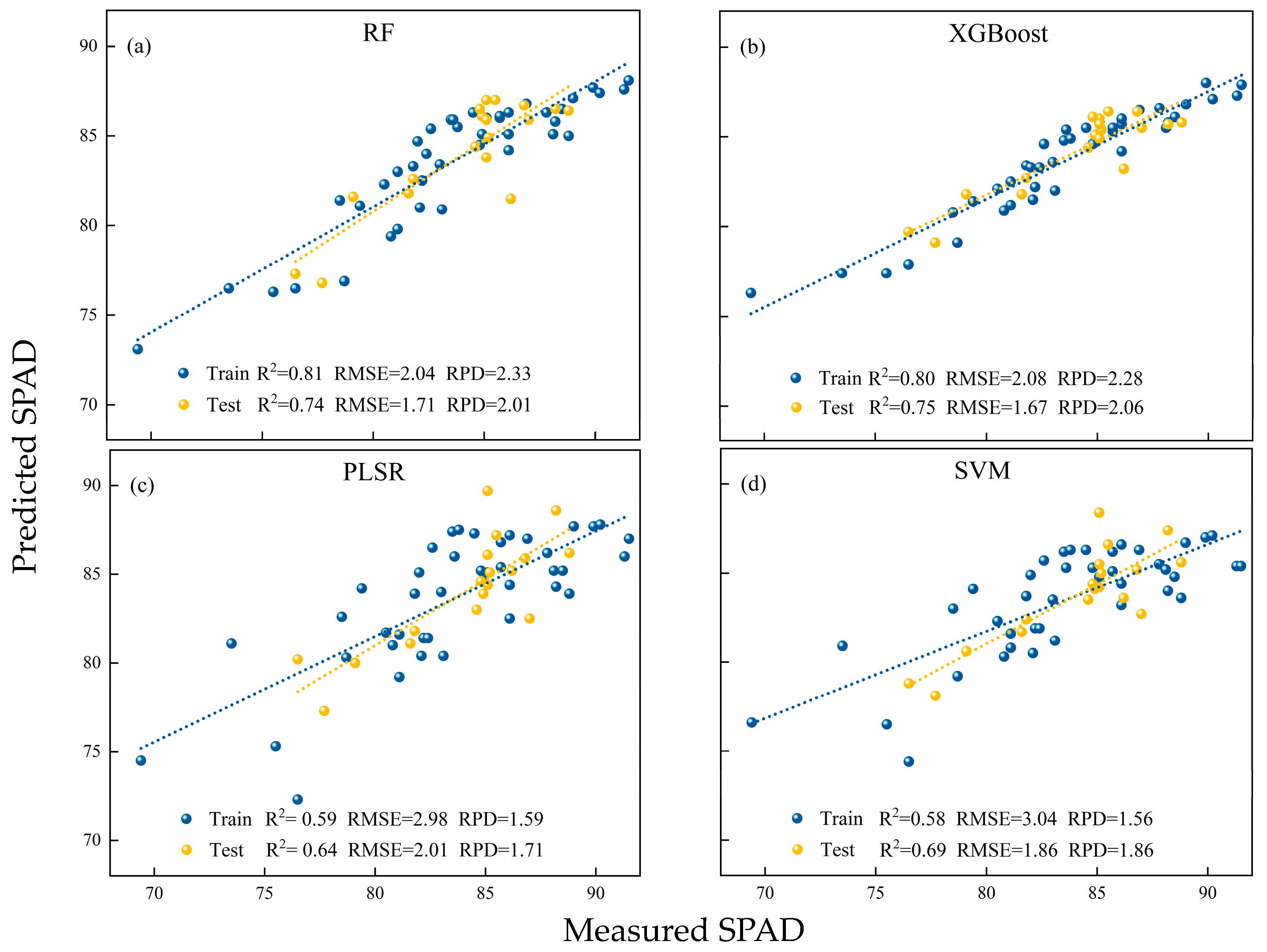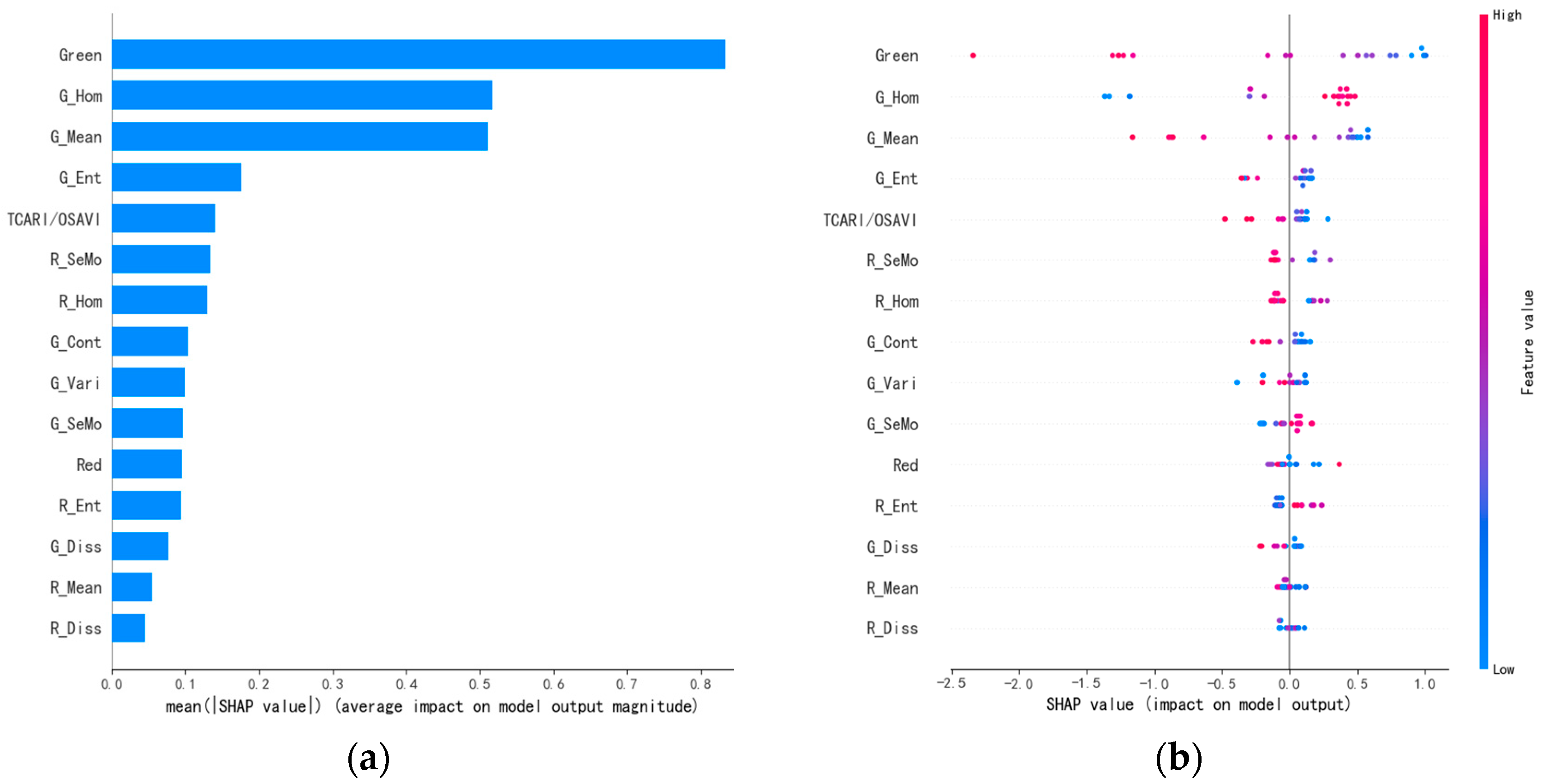A Multi-Feature Estimation Model for Olive Canopy Chlorophyll Combining XGBoost with UAV Imagery
Abstract
1. Introduction
2. Materials and Methods
2.1. Study Area and Experimental Design
2.2. Ground-Based SPAD Measurement Data Acquisition
2.3. Acquisition and Processing of Multispectral Data from Unmanned Aerial Vehicles
2.4. Single-Band, Vegetation Indices, and Texture Feature Extraction
2.5. Feature Selection
2.6. Model Construction
2.7. Model Accuracy Evaluation
2.8. SHAP Analysis for Model Interpretability
3. Results
3.1. Correlation Between Multiple Features and SPAD
3.2. Univariate Linear Regression (LR) Inversion Model
3.3. Construction of RF, XGBoost, PLSR, and SVM Inversion Models
3.4. Interpretation of XGBoost Model Using SHAP
4. Discussion
4.1. Correlation Between Multiple Features and Chlorophyll Content in the Complex Canopy of Olive Trees
4.2. Significance and Applicability Analysis of Univariate Linear Regression in the Estimation of SPAD in Olive Oil
4.3. Significance and Applicability Analysis of Different Machine Learning Modeling Algorithms in SPAD Estimation of Olive Oil
4.4. Research Significance and Future Prospects
5. Conclusions
Author Contributions
Funding
Data Availability Statement
Conflicts of Interest
References
- International Olive Council. World Market of Olive Oil and Table Olives—Data from December 2024. Available online: https://www.internationaloliveoil.org/world-market-of-olive-oil-and-table-olives-data-from-december-2024/ (accessed on 1 August 2025).
- Angulo, L.A.; Laaroussi, H.; Ousaaid, D.; Bakour, M.; Lyoussi, B.; Ferreira-Santos, P. Sustainable Valorization of Olive Oil By-Products: Green Extraction of Phytochemicals, Encapsulation Strategies, and Food Applications. J. Food Sci. 2025, 90, e70412. [Google Scholar] [CrossRef] [PubMed]
- FAO. More per Drop: Building Resilience and Adding Value in Morocco’s Olive Oil Sector. Available online: https://www.fao.org/investment-centre/latest/news/detail/more-per-drop--building-resilience-and-adding-value-in-morocco-s-olive-oil-sector/en (accessed on 1 August 2025).
- International Olive Council. IOC Newsletter No. 190 (May–June 2024). Available online: https://www.internationaloliveoil.org/wp-content/uploads/2024/06/NEWSLETTER_190_ENG.pdf (accessed on 1 August 2025).
- Zhang, Y.; Wei, L.; Zhou, Y.; Kou, W.; Fauzi, S.S.M. Integrating UAV-RGB Spectral Indices by Deep Learning Model Enables High-Precision Olive Tree Segmentation Under Small Sample. Forests 2025, 16, 924. [Google Scholar] [CrossRef]
- Gitelson, A.A.; Gritz, Y.; Merzlyak, M.N. Relationships between leaf chlorophyll content and spectral reflectance and algorithms for non-destructive chlorophyll assessment in higher plant leaves. J. Plant Physiol. 2003, 160, 271–282. [Google Scholar] [CrossRef]
- Delalieux, S.; Vandermaesen, J.; Vanbrabant, Y.; Wuyts, M.; Dierckx, W.; Tits, L. The uncharted territory of drone-based cross-season monitoring for precision horticulture. In Proceedings of the 13th European Conference on Precision Agriculture, Budapest, Hungary, 18–22 July 2021. [Google Scholar] [CrossRef]
- Ye, H.; Huang, W.; Huang, S.; Cui, B.; Dong, Y.; Guo, A.; Ren, Y.; Jin, Y. Recognition of banana fusarium wilt based on UAV remote sensing. Remote Sens. 2020, 12, 938. [Google Scholar] [CrossRef]
- Yin, H.; Huang, W.; Li, F.; Yang, H.; Li, Y.; Hu, Y.; Yu, K. Multi-temporal UAV imaging-based mapping of chlorophyll content in potato crop. PFG-J. Photogramm. Remote Sens. Geoinf. Sci. 2023, 91, 91–106. [Google Scholar] [CrossRef]
- Guo, Y.; Wang, H.; Wu, Z.; Wang, S.; Sun, H.; Senthilnath, J.; Wang, J.; Robin Bryant, C.; Fu, Y. Modified red blue vegetation index for chlorophyll estimation and yield prediction of maize from visible images captured by UAV. Sensors 2020, 20, 5055. [Google Scholar] [CrossRef]
- Fu, G.; Li, C.; Liu, W.; Pan, K.; He, J.; Li, W. Maize yield estimation based on UAV multispectral monitoring of canopy LAI and WOFOST data assimilation. Eur. J. Agron. 2025, 168, 127614. [Google Scholar] [CrossRef]
- Wang, J.; Zhang, Y.; Han, F.; Shi, Z.; Zhao, F.; Zhang, F.; Pan, W.; Zhang, Z.; Cui, Q. Estimation of Canopy Chlorophyll Content of Apple Trees Based on UAV Multispectral Remote Sensing Images. Agriculture 2025, 15, 1308. [Google Scholar] [CrossRef]
- Liu, Q.; Wu, Z.; Cui, N.; Zheng, S.; Zhu, S.; Jiang, S.; Wang, Z.; Gong, D.; Wang, Y.; Zhao, L. Soil moisture content estimation of drip-irrigated citrus orchard based on UAV images and machine learning algorithm in Southwest China. Agric. Water Manag. 2024, 303, 109069. [Google Scholar] [CrossRef]
- Khormizi, H.Z.; Malamiri, H.R.G.; Ferreira, C.S.S. Estimation of Evaporation and Drought Stress of Pistachio Plant Using UAV Multispectral Images and a Surface Energy Balance Approach. Horticulturae 2024, 10, 515. [Google Scholar] [CrossRef]
- Zhou, L.; Zhang, Y.; Chen, H.; Sun, G.; Wang, L.; Li, M.; Sun, X.; Feng, P.; Yan, L.; Qiu, L.; et al. Soybean yield estimation and lodging classification based on UAV multi-source data and self-supervised contrastive learning. Comput. Electron. Agric. 2025, 230, 109822. [Google Scholar] [CrossRef]
- Yue, J.; Yang, H.; Yang, G.; Fu, Y.; Wang, H.; Zhou, C. Estimating vertically growing crop above-ground biomass based on UAV remote sensing. Comput. Electron. Agric. 2023, 205, 107627. [Google Scholar] [CrossRef]
- Zhang, C.; Chen, Z.; Chen, R.; Zhang, W.; Zhao, D.; Yang, G.; Xu, B.; Feng, H.; Yang, H. Retrieving the chlorophyll content of individual apple trees by reducing canopy shadow impact via a 3D radiative transfer model and UAV multispectral imagery. Plant Phenomics 2025, 7, 100015. [Google Scholar] [CrossRef]
- Singh, K.; Huang, Y.; Young, W.; Harvey, L.; Hall, M.; Zhang, X.; Lobaton, E.; Jenkins, J.; Shankle, M. Sweet Potato Yield Prediction Using Machine Learning Based on Multispectral Images Acquired from a Small Unmanned Aerial Vehicle. Agriculture 2025, 15, 420. [Google Scholar] [CrossRef]
- Biswal, S.; Pathak, N.; Chatterjee, C.; Mailapalli, D.R. Estimation of aboveground biomass from spectral and textural characteristics of paddy crop using UAV-multispectral images and machine learning techniques. Geocarto Int. 2024, 39, 2364725. [Google Scholar] [CrossRef]
- Wang, R.; Tuerxun, X.; Zheng, J. Improved estimation of SPAD values in walnut leaves by combining spectral, texture, and structural information from UAV-based multispectral image. Sci. Hortic.-Amst. 2024, 328, 112940. [Google Scholar] [CrossRef]
- Gao, C.; Li, H.; Wang, J.; Zhang, X.; Huang, K.; Song, X.; Yang, W.; Feng, M.; Xiao, L.; Zhao, Y.; et al. Combined use of spectral resampling and machine learning algorithms to estimate soybean leaf chlorophyll. Comput. Electron. Agric. 2024, 218, 108675. [Google Scholar] [CrossRef]
- Sánchez, M.R.; Silva, C.A.A.C.; Demattê, J.A.M.; Mendonça, F.C.; Silva, M.A.d.; Romanelli, T.L.; Fiorio, P.R. Predictive modelling of chlorophyll in Mombaça grass leaves by hyperspectral reflectance data and machine learning. Grass Forage Sci. 2024, 79, 543–556. [Google Scholar] [CrossRef]
- Khan, M.S.; Yadav, P.; Semwal, M.; Prasad, N.; Verma, R.K.; Kumar, D. Predicting canopy chlorophyll concentration in citronella crop using machine learning algorithms and spectral vegetation indices derived from UAV multispectral imagery. Ind. Crops Prod. 2024, 219, 119147. [Google Scholar] [CrossRef]
- Narmilan, A.; Gonzalez, F.; Salgadoe, A.S.A.; Kumarasiri, U.W.L.M.; Weerasinghe, H.A.S.; Kulasekara, B.R. Predicting Canopy Chlorophyll Content in Sugarcane Crops Using Machine Learning Algorithms and Spectral Vegetation Indices Derived from UAV Multispectral Imagery. Remote Sens. 2022, 14, 1140. [Google Scholar] [CrossRef]
- Elsayed, S.; El-Hendawy, S.; Elsherbiny, O.; Okasha, A.M.; Elmetwalli, A.H.; Elwakeel, A.E.; Memon, M.S.; Ibrahim, M.E.M.; Ibrahim, H.H. Estimating Chlorophyll Content, Production, and Quality of Sugar Beet under Various Nitrogen Levels Using Machine Learning Models and Novel Spectral Indices. Agronomy 2023, 13, 2743. [Google Scholar] [CrossRef]
- Benítez, M.L.; Pedrajas, V.M.; del Campillo, M.C.; Torrent, J. Iron chlorosis in olive in relation to soil properties. Nutr. Cycl. Agroecosys. 2002, 62, 47–52. [Google Scholar] [CrossRef]
- Machado de Souza, F.B.; Toledo Coelho, V.A.; Pio, R.; Rodas, C.L.; Pereira da Silva, I.; de Melo, E.T.; da Hora Farias, D. Visual symptoms and nutritional deficiencies in olive plants subjected to nutrient deprivation. Acta Sci. Agron. 2019, 41, e39582. [Google Scholar] [CrossRef]
- Connor, D.J. Adaptation of olive (Olea europaea L.) to water-limited environments. Aust. J. Agric. Res. 2005, 56, 1181–1189. [Google Scholar] [CrossRef]
- Buonaurio, R.; Almadi, L.; Famiani, F.; Moretti, C.; Agosteo, G.E.; Schena, L. Olive leaf spot caused by Venturia oleaginea: An updated review. Front. Plant Sci. 2022, 13, 1061136. [Google Scholar] [CrossRef]
- Bacelar, E.A.; Correia, C.M.; Moutinho-Pereira, J.M.; Gonçalves, B.C.; Lopes, J.I.; Torres-Pereira, J.M.G. Sclerophylly and leaf anatomical traits of five field-grown olive cultivars growing under drought conditions. Tree Physiol. 2004, 24, 233–239. [Google Scholar] [CrossRef]
- Shibaeva, T.G.; Mamaev, A.V.; Sherudilo, E.G. Evaluation of a SPAD-502 Plus Chlorophyll Meter to Estimate Chlorophyll Content in Leaves with Interveinal Chlorosis. Russ. J. Plant Physl. 2020, 67, 690–696. [Google Scholar] [CrossRef]
- Zhang, R.; Yang, P.; Liu, S.; Wang, C.; Liu, J. Evaluation of the Methods for Estimating Leaf Chlorophyll Content with SPAD Chlorophyll Meters. Remote Sens. 2022, 14, 5144. [Google Scholar] [CrossRef]
- Uddling, J.; Gelang-Alfredsson, J.; Piikki, K.; Pleijel, H. Evaluating the relationship between leaf chlorophyll concentration and SPAD-502 chlorophyll meter readings. Photosynth. Res. 2007, 91, 37–46. [Google Scholar] [CrossRef]
- Tu, Y.-H.; Phinn, S.; Johansen, K.; Robson, A.; Wu, D. Optimising drone flight planning for measuring horticultural tree crop structure. ISPRS J. Photogramm. 2020, 160, 83–96. [Google Scholar] [CrossRef]
- Brewer, K.; Clulow, A.; Sibanda, M.; Gokool, S.; Naiken, V.; Mabhaudhi, T. Predicting the chlorophyll content of maize over phenotyping as a proxy for crop health in smallholder farming systems. Remote Sens. 2022, 14, 518. [Google Scholar] [CrossRef]
- Liu, Y.; Feng, H.; Yue, J.; Jin, X.; Li, Z.; Yang, G. Estimation of potato above-ground biomass based on unmanned aerial vehicle red–green–blue images with different texture features and crop height. Front. Plant Sci. 2022, 13, 938216. [Google Scholar] [CrossRef]
- Haghighian, F.; Yousefi, S.; Keesstra, S. Identifying tree health using sentinel-2 images: A case study on Tortrix viridana L. infected oak trees in Western Iran. Geocarto Int. 2022, 37, 304–314. [Google Scholar] [CrossRef]
- De Castro, A.I.; Shi, Y.; Maja, J.M.; Peña, J.M. UAVs for vegetation monitoring: Overview and recent scientific contributions. Remote Sens. 2021, 13, 2139. [Google Scholar] [CrossRef]
- Zhao, X.; Li, Y.; Chen, Y.; Qiao, X.; Qian, W. Water chlorophyll a estimation using UAV-based multispectral data and machine learning. Drones 2022, 7, 2. [Google Scholar] [CrossRef]
- Sripada, R.P.; Heiniger, R.W.; White, J.G.; Weisz, R. Aerial color infrared photography for determining late-season nitrogen requirements in corn. Agron. J. 2005, 97, 1443–1451. [Google Scholar] [CrossRef]
- Jasper, J.; Reusch, S.; Link, A. Active sensing of the N status of wheat using optimized wavelength combination: Impact of seed rate, variety and growth stage. In Proceedings of the Precision Agriculture’09, European Conference on Precision Agriculture, Wageningen, The Netherlands, 6–8 July 2009. [Google Scholar] [CrossRef]
- Zha, Y.; Gao, J.; Ni, S. Use of normalized difference built-up index in automatically mapping urban areas from TM imagery. Int. J. Remote Sens. 2003, 24, 583–594. [Google Scholar] [CrossRef]
- Datt, B. Visible/near infrared reflectance and chlorophyll content in Eucalyptus leaves. Int. J. Remote Sens. 1999, 20, 2741–2759. [Google Scholar] [CrossRef]
- Cao, Q.; Miao, Y.; Wang, H.; Huang, S.; Cheng, S.; Khosla, R.; Jiang, R. Non-destructive estimation of rice plant nitrogen status with Crop Circle multispectral active canopy sensor. Field Crops Res. 2013, 154, 133–144. [Google Scholar] [CrossRef]
- Xiao, Y.; Zhao, W.; Zhou, D.; Gong, H. Sensitivity analysis of vegetation reflectance to biochemical and biophysical variables at leaf, canopy, and regional scales. IEEE Trans. Geosci. Remote Sens. 2013, 52, 4014–4024. [Google Scholar] [CrossRef]
- Huang, W.; Yang, Q.; Pu, R.; Yang, S. Estimation of nitrogen vertical distribution by bi-directional canopy reflectance in winter wheat. Sensors 2014, 14, 20347–20359. [Google Scholar] [CrossRef]
- Tahir, M.N.; Naqvi, S.Z.A.; Lan, Y.; Zhang, Y.; Wang, Y.; Afzal, M.; Cheema, M.J.M.; Amir, S.R. Real time monitoring chlorophyll content based on vegetation indices derived from multispectral UAVs in the kinnow orchard. Int. J. Precis. Agric. Aviat. 2018, 1, 24–31. [Google Scholar] [CrossRef]
- Chen, J.M. Evaluation of vegetation indices and a modified simple ratio for boreal applications. Can. J. Remote Sens. 1996, 22, 229–242. [Google Scholar] [CrossRef]
- Devadas, R.; Lamb, D.W.; Simpfendorfer, S.; Backhouse, D. Evaluating ten spectral vegetation indices for identifying rust infection in individual wheat leaves. Precis. Agric. 2009, 10, 459–470. [Google Scholar] [CrossRef]
- Rondeaux, G.; Steven, M.; Baret, F. Optimization of soil-adjusted vegetation indices. Remote Sens. Environ. 1996, 55, 95–107. [Google Scholar] [CrossRef]
- Wu, C.; Niu, Z.; Tang, Q.; Huang, W. Estimating chlorophyll content from hyperspectral vegetation indices: Modeling and validation. Agric. For. Meteorol. 2008, 148, 1230–1241. [Google Scholar] [CrossRef]
- Benesty, J.; Chen, J.; Huang, Y.; Cohen, I. Pearson Correlation Coefficient. In Noise Reduction in Speech Processing; Cohen, I., Benesty, J., Huang, Y., Eds.; Springer: Berlin/Heidelberg, Germany, 2009; Volume 2, pp. 1–4. [Google Scholar] [CrossRef]
- Belgiu, M.; Drăguţ, L. Random forest in remote sensing: A review of applications and future directions. ISPRS J. Photogramm. Remote Sens. 2016, 114, 24–31. [Google Scholar] [CrossRef]
- Wang, D.; Xing, Y.; Fu, A.; Tang, J.; Chang, X.; Yang, H.; Yang, S.; Li, Y. Mapping Forest Aboveground Biomass Using Multi-Source Remote Sensing Data Based on the XGBoost Algorithm. Forests 2025, 16, 347. [Google Scholar] [CrossRef]
- Luedeling, E.; Gassner, A. Partial Least Squares Regression for analyzing walnut phenology in California. Agric. For. Meteorol. 2012, 158–159, 43–52. [Google Scholar] [CrossRef]
- Felipetto, H.S.; Mercante, E.; Viana, O.; Elias, A.R.; Benin, G.; Scolari, L.; Armadori, A.; Donato, D.G. Combining machine learning with UAV derived multispectral aerial images for wheat yield prediction, in southern Brazil. Eur. J. Remote Sens. 2025, 58, 2464663. [Google Scholar] [CrossRef]
- Gaston, E.; Frías, J.M.; Cullen, P.J.; O’Donnell, C.P.; Gowen, A.A. Prediction of Polyphenol Oxidase Activity Using Visible Near-Infrared Hyperspectral Imaging on Mushroom (Agaricus bisporus) Caps. J. Agric. Food Chem. 2010, 58, 6226–6233. [Google Scholar] [CrossRef]
- Lundberg, S.M.; Erion, G.; Chen, H.; DeGrave, A.; Prutkin, J.M.; Nair, B.; Katz, R.; Himmelfarb, J.; Bansal, N.; Lee, S.-I. From local explanations to global understanding with explainable AI for trees. Nat. Mach. Intell. 2020, 2, 56–67. [Google Scholar] [CrossRef] [PubMed]
- Zhang, C.; Chen, Z.; Yang, G.; Xu, B.; Feng, H.; Chen, R.; Qi, N.; Zhang, W.; Zhao, D.; Cheng, J.; et al. Removal of canopy shadows improved retrieval accuracy of individual apple tree crowns LAI and chlorophyll content using UAV multispectral imagery and PROSAIL model. Comput. Electron. Agric. 2024, 221, 108959. [Google Scholar] [CrossRef]
- Vogelmann, T.C.; Evans, J.R. Profiles of light absorption and chlorophyll within spinach leaves from chlorophyll fluorescence. Plant Cell Environ. 2002, 25, 1313–1323. [Google Scholar] [CrossRef]
- Poblete, T.; Watt, M.S.; Buddenbaum, H.; Zarco-Tejada, P.J. Chlorophyll content estimation in radiata pine using hyperspectral imagery: A comparison between empirical models, scaling-up algorithms, and radiative transfer inversions. Agric. For. Meteorol. 2025, 362, 110402. [Google Scholar] [CrossRef]
- Guermazi, E.; Wali, A.; Ksibi, M. Combining remote sensing, SPAD readings, and laboratory analysis for monitoring olive groves and olive oil quality. Precis. Agric. 2024, 25, 65–82. [Google Scholar] [CrossRef]
- Song, Z.; Liu, Y.; Yu, J.; Guo, Y.; Jiang, D.; Zhang, Y.; Guo, Z.; Chang, Q. Estimation of Chlorophyll Content in Apple Leaves Infected with Mosaic Disease by Combining Spectral and Textural Information Using Hyperspectral Images. Remote Sens. 2023, 16, 2190. [Google Scholar] [CrossRef]
- Abdikan, S.; Sekertekin, A.; Narin, O.G.; Delen, A.; Sanli, F.B. A comparative analysis of SLR, MLR, ANN, XGBoost and CNN for crop height estimation of sunflower using Sentinel-1 and Sentinel-2. Adv. Space Res. 2023, 71, 3045–3059. [Google Scholar] [CrossRef]
- Angel, Y.; McCabe, M.F. Machine Learning Strategies for the Retrieval of Leaf-Chlorophyll Dynamics: Model Choice, Sequential Versus Retraining Learning, and Hyperspectral Predictors. Front. Plant Sci. 2022, 13, 722442. [Google Scholar] [CrossRef] [PubMed]
- Hussain, S.; Teshome, F.T.; Tulu, B.B.; Awoke, G.W.; Hailegnaw, N.S.; Bayabil, H.K. Leaf area index (LAI) prediction using machine learning and UAV based vegetation indices. Eur. J. Agron. 2025, 168, 127557. [Google Scholar] [CrossRef]
- Tunca, E.; Köksal, E.S.; Akay, H.; Öztürk, E.; Taner, S.Ç. Novel machine learning framework for high-resolution sorghum biomass estimation using multi-temporal UAV imagery. Int. J. Environ. Sci. Technol. 2025, 22, 13673–13688. [Google Scholar] [CrossRef]
- Thieme, A.; Jennewein, J.; Hively, W.D.; Lamb, B.T.; Whitcraft, A.K.; Mirsky, S.B.; Reberg-Horton, S.C.; Justice, C. Multispectral red-edge indices accurately estimate nitrogen content in winter cereal cover crops. Agron. J. 2025, 117, e70011. [Google Scholar] [CrossRef]
- Constantin, J.; Minette, S.; Vericel, G.; Jordan-Meille, L.; Justes, E. MERCI: A simple method and decision-support tool to estimate availability of nitrogen from a wide range of cover crops to the next cash crop. Plant Soil 2024, 494, 333–351. [Google Scholar] [CrossRef]
- Khlghatyan, A.; Medvedev, A.; Muradyan, V.; Hovsepyan, A.; Avetisyan, R.; Ayvazyan, G.; Parseghyan, A.; Asmaryan, S. Exploring multisource remote sensing capacities for spatiotemporal analysis and quantification of chlorophyll of vineyards in Armenia. Agric. Res. 2025, 1–17. [Google Scholar] [CrossRef]
- Zhu, W.; Sun, Z.; Huang, Y.; Yang, T.; Li, J.; Zhu, K.; Zhang, J.; Yang, B.; Shao, C.; Peng, J.; et al. Optimization of multi-source UAV RS agro-monitoring schemes designed for field-scale crop phenotyping. Precis. Agric. 2021, 22, 1768–1802. [Google Scholar] [CrossRef]
- Wang, L.; Zhang, H.; Bian, L.; Zhou, L.; Wang, S.; Ge, Y. Poplar seedling varieties and drought stress classification based on multi-source, time-series data and deep learning. Ind. Crops Prod. 2024, 218, 118905. [Google Scholar] [CrossRef]
- Qiu, S.; Zhu, X.; Zhang, Q.; Tao, X.; Zhou, K. Enhanced estimation of crown-level leaf dry biomass of Ginkgo saplings based on multi-height UAV imagery and digital aerial photogrammetry point cloud data. Forests 2024, 15, 1720. [Google Scholar] [CrossRef]
- Yue, Z.; Zhang, Q.; Zhu, X.; Zhou, K. Chlorophyll content estimation of Ginkgo seedlings based on deep learning and hyperspectral imagery. Forests 2024, 15, 2010. [Google Scholar] [CrossRef]
- Zhou, K.; Qiu, S.; Cao, F.; Wang, G.; Cao, L. Coupling PROSPECT with prior estimation of leaf structure to improve the retrieval of leaf nitrogen content in Ginkgo from bidirectional reflectance factor spectra. Plant Phenomics 2024, 6, 0282. [Google Scholar] [CrossRef] [PubMed]






| Vegetation Indices | Formula | References |
|---|---|---|
| Normalized Difference Vegetation Index (NDVI) | [37] | |
| Green Difference Vegetation Index (GDVI) | [9] | |
| Normalized Difference Rededge Index (NDRE) | [38] | |
| Green Normalized Difference Vegetation (GNDVI) | [39] | |
| Green Optimized Soil Adjusted Vegetation (GOSAVI) | [40] | |
| Red Edge Ratio Vegetation Index (RERVI) | [41] | |
| Normalized Difference Index (NDI) | [42] | |
| Green Soil Adjusted Vegetation Index (GSAVI) | [40] | |
| DATT | [43] | |
| Normalized Red Edge Index (NREI) | [44] | |
| Modified Chlorophyll Absorption In Reflectance Index (MCARI) | [45] | |
| Normalized Red Vegetation Index (NRI) | [46] | |
| Modified Enhanced Vegetation Index (MEVI) | [44] | |
| Transformed Normalized Difference Vegetation Index (TNDVI) | [47] | |
| Modified Simple Radio Soil-Adjusted Vegetation Index (MSR) | [48] | |
| Transformed Chlorophyll Absorption Reflectance Index (TCARI) | [49] | |
| Optimized Soil-Adjusted Vegetation Index (OSAVI) | [50] | |
| TCARI/OSAVI | [51] |
| Features | Expression | Training Set | Validation Set | ||||
|---|---|---|---|---|---|---|---|
| R2 | RMSE | RPD | R2 | RMSE | RPD | ||
| G | y = −888.4677x + 117.2071 | 0.53 | 3.21 | 1.48 | 0.68 | 1.90 | 1.81 |
| R | y = −540.4216x + 102.8125 | 0.30 | 3.92 | 1.21 | 0.62 | 2.08 | 1.66 |
| TCARI/OSAVI | y = −112.4576x + 104.4479 | 0.25 | 4.06 | 1.17 | 0.33 | 2.75 | 1.26 |
| R_Mean | y = −1.4082x + 102.1744 | 0.30 | 3.91 | 1.21 | 0.62 | 2.05 | 1.68 |
| R_Hom | y = 45.1415x + 54.1591 | 0.17 | 4.27 | 1.11 | 0.57 | 2.20 | 1.57 |
| R_Diss | y = −8.5110x + 92.7537 | 0.13 | 4.37 | 1.08 | 0.51 | 2.34 | 1.48 |
| R_Ent | y = −16.1965x + 107.2985 | 0.17 | 4.26 | 1.11 | 0.53 | 2.30 | 1.50 |
| R_SeMo | y = 51.8824x + 68.9077 | 0.17 | 4.27 | 1.11 | 0.50 | 2.36 | 1.46 |
| G_Mean | y = −2.1226x + 116.0596 | 0.53 | 3.21 | 1.47 | 0.68 | 1.88 | 1.83 |
| G_Vari | y = −2.3749x + 92.1192 | 0.25 | 4.05 | 1.17 | 0.48 | 2.40 | 1.43 |
| G_Hom | y = 61.7750x + 46.3448 | 0.34 | 3.79 | 1.25 | 0.41 | 2.57 | 1.34 |
| G_Cont | y = −0.8193x + 89.6520 | 0.17 | 4.25 | 1.11 | 0.46 | 2.47 | 1.40 |
| Models | Training Set | Validation Set | ||||
|---|---|---|---|---|---|---|
| R2 | RMSE | RPD | R2 | RMSE | RPD | |
| RF | 0.73 | 2.41 | 1.96 | 0.74 | 1.71 | 2.01 |
| XGBoost | 0.78 | 2.17 | 2.18 | 0.75 | 1.67 | 2.06 |
| PLSR | 0.61 | 2.92 | 1.62 | 0.64 | 2.01 | 1.71 |
| SVM | 0.57 | 3.05 | 1.55 | 0.69 | 1.86 | 1.86 |
Disclaimer/Publisher’s Note: The statements, opinions and data contained in all publications are solely those of the individual author(s) and contributor(s) and not of MDPI and/or the editor(s). MDPI and/or the editor(s) disclaim responsibility for any injury to people or property resulting from any ideas, methods, instructions or products referred to in the content. |
© 2025 by the authors. Licensee MDPI, Basel, Switzerland. This article is an open access article distributed under the terms and conditions of the Creative Commons Attribution (CC BY) license (https://creativecommons.org/licenses/by/4.0/).
Share and Cite
Zhuang, W.; Li, D.; Kou, W.; Lu, N.; Wu, F.; Sun, S.; Liu, Z. A Multi-Feature Estimation Model for Olive Canopy Chlorophyll Combining XGBoost with UAV Imagery. Agronomy 2025, 15, 2718. https://doi.org/10.3390/agronomy15122718
Zhuang W, Li D, Kou W, Lu N, Wu F, Sun S, Liu Z. A Multi-Feature Estimation Model for Olive Canopy Chlorophyll Combining XGBoost with UAV Imagery. Agronomy. 2025; 15(12):2718. https://doi.org/10.3390/agronomy15122718
Chicago/Turabian StyleZhuang, Weiyu, Dong Li, Weili Kou, Ning Lu, Fan Wu, Shixian Sun, and Zhefeng Liu. 2025. "A Multi-Feature Estimation Model for Olive Canopy Chlorophyll Combining XGBoost with UAV Imagery" Agronomy 15, no. 12: 2718. https://doi.org/10.3390/agronomy15122718
APA StyleZhuang, W., Li, D., Kou, W., Lu, N., Wu, F., Sun, S., & Liu, Z. (2025). A Multi-Feature Estimation Model for Olive Canopy Chlorophyll Combining XGBoost with UAV Imagery. Agronomy, 15(12), 2718. https://doi.org/10.3390/agronomy15122718









